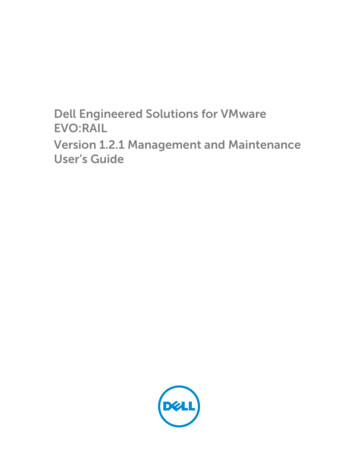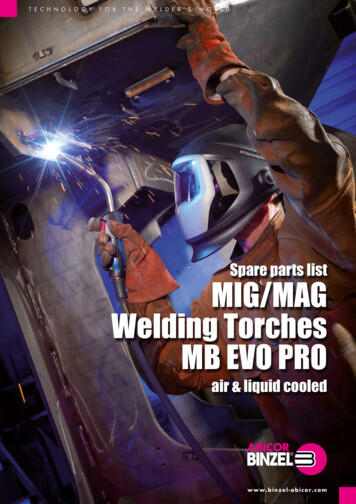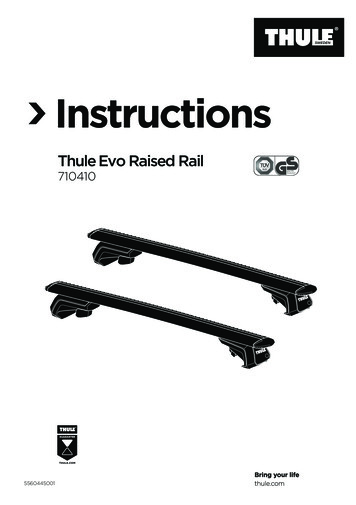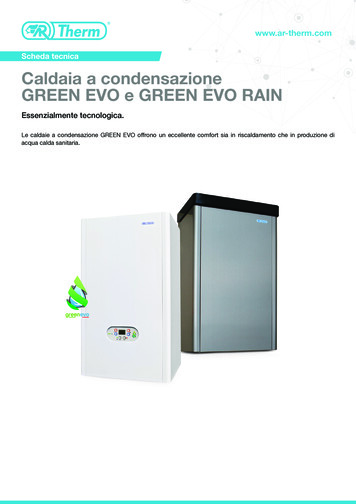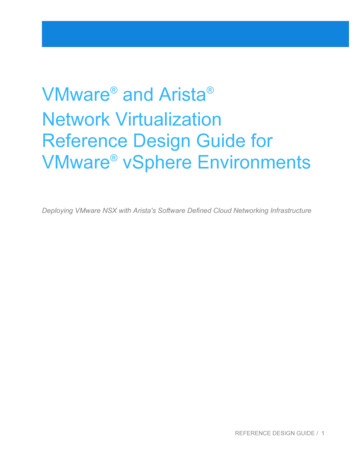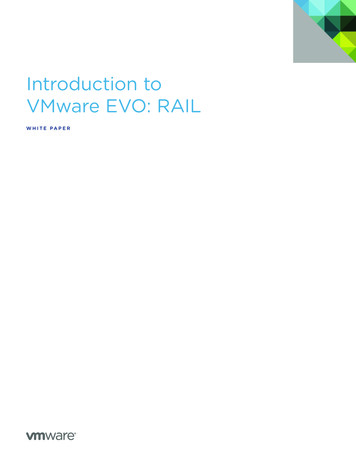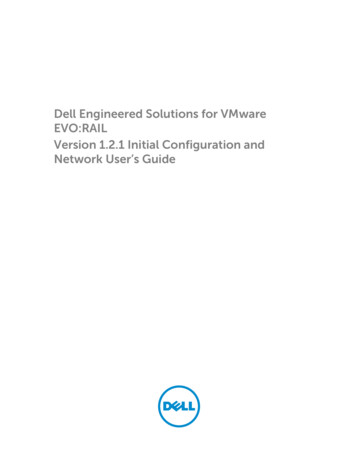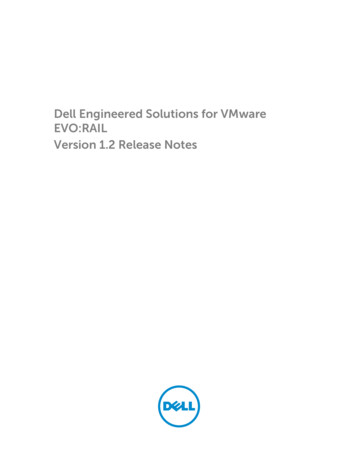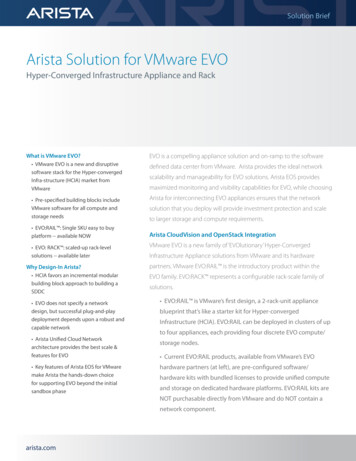
Transcription
Solution BriefArista Solution for VMware EVOHyper-Converged Infrastructure Appliance and RackWhat is VMware EVO?EVO is a compelling appliance solution and on-ramp to the software VMware EVO is a new and disruptivesoftware stack for the Hyper-convergedInfra-structure (HCIA) market fromVMwaredefined data center from VMware. Arista provides the ideal network Pre-specified building blocks includeVMware software for all compute andstorage needsArista for interconnecting EVO appliances ensures that the network EVO:RAIL : Single SKU easy to buyplatform -- available NOW EVO: RACK : scaled-up rack-levelsolutions -- available laterWhy Design-In Arista? HCIA favors an incremental modularbuilding block approach to building aSDDC EVO does not specify a networkdesign, but successful plug-and-playdeployment depends upon a robust andcapable network Arista Unified Cloud Networkarchitecture provides the best scale &features for EVO Key features of Arista EOS for VMwaremake Arista the hands-down choicefor supporting EVO beyond the initialsandbox phasescalability and manageability for EVO solutions. Arista EOS providesmaximized monitoring and visibility capabilities for EVO, while choosingsolution that you deploy will provide investment protection and scaleto larger storage and compute requirements.Arista CloudVision and OpenStack IntegrationVMware EVO is a new family of ‘EVOlutionary’ Hyper-ConvergedInfrastructure Appliance solutions from VMware and its hardwarepartners. VMware EVO:RAIL is the introductory product within theEVO family. EVO:RACK represents a configurable rack-scale family ofsolutions. EVO:RAIL is VMware’s first design, a 2-rack-unit applianceblueprint that’s like a starter kit for Hyper-convergedInfrastructure (HCIA). EVO:RAIL can be deployed in clusters of upto four appliances, each providing four discrete EVO compute/storage nodes. Current EVO:RAIL products, available from VMware’s EVOhardware partners (at left), are pre-configured software/hardware kits with bundled licenses to provide unified computeand storage on dedicated hardware platforms. EVO:RAIL kits areNOT purchasable directly from VMware and do NOT contain anetwork component.arista.com
Solution BriefAs the first deliverable under the EVOprogram, EVO:RAIL will leverage VDI asthe key driver for early adoption of clusterappliances, followed by applications inremote offices — as it was in the case forearly adopters of prior HCIA solutions. EVO:RACK is a scaled-up solution that can scale to tens of racks, meeting theincreasing demands of private clouds at medium-to-large enterprises. It canrun on a range of pre-integrated hardware configurations ranging from OpenCompute Project based hardware designs to industry-standard OEM serversand converged infrastructure. EVO’s configuration engine is an HTML5 (no JAVA required) web-basedmanagement front-end that provides streamlined and automated lifecyclemanagement of all EVO components, including non-disruptive patching andupgrading of software, hardware management, and workload visibility.Understanding EVO - Use CasesAs the first deliverable under the EVO program, EVO:RAIL will leverage VDI as the keydriver for early adoption of cluster appliances, followed by applications in remoteoffices — as it was in the case for early adopters of prior HCIA solutions. In addition,there will be EVO:RACK and EVO:RAIL variants that have the hardware and softwaretuned to support scale-out storage and analytics for big data workloads (Hadoop,NoSQL and Cassandra), and to run other general purpose applications and cloudframeworks (IaaS/PaaS) atop the converged EVO cloud.Figure 1: VMware EVO:RAIL Primary Use CasesA key example of expected EVO:RAIL deployment is for remote offices with zero ITstaffing. An EVO:RAIL appliance can be shipped to the remote office, wired by a nonIT employee and then configured from a remote location. Besides using the setupwizard, the appliance can also be configured using a JSON configuration file. Justload the file and it’s ready. This ensures a consistent configuration across multipleremote offices.Approaches to Building your SDDCEVO is as much a transformation in business models as it is a technology packagingstrategy from VMware, very much in line with the transformation of IT practicesto the cloud. By embracing a hyper-converged approach to building the SoftwareDefined Data Center, enabled through a broad list of qualified system suppliers,VMware is driving inflexibility, single-sourcing, complex procurement, andgratuitous vendor differentiation out of the equation.VMware EVO promises to make procurement of SDDC components more open,flexible, modular, and simpler while providing a support ecosystem that can providea single point of resolution for any problems encountered.arista.com
Solution BriefFigure 2: Three Approaches to Building the SDDCEVO Systems Design & ScaleEVO:RAIL system scale initially spans from four to sixteen physical server nodes tooffer from 100 to 400 virtual machines running applications, or from 250 to 1,000virtual desktops for VDI. All nodes run vSphere ESXi with a single vCenter instance,some additional EVO:RAIL management software, vRealize Operations Insight forcluster performance management and troubleshooting, and VMware Virtual SANTMfor storage.Each of the servers in an EVO:RAIL cluster have two 10GbE links connected to a Topof-Rack switch, and one BMC/IPMI GbE interface for remote management. EVO:RAILsoftware handles all of the deployment, configuration and management — so youcan grow compute and storage automatically as additional appliances are addedand discovered. Currently you can increase the size of an individual EVO:RAIL clusterto as many as 16 physical nodes, though larger scales are expected to be supportedin the future.Note: ToR network switches and other networking infrastructure are not part of an EVO:RAILSKU. These may be sold as add-ons by VMware partners or their resellers, or they may bepurchased separately by the customer.EVO Systems Design & ScaleToday’s EVO:RAIL discovery and automation features require a robust networkinfrastructure supporting IPv6 and IP Multicast. For example, during setup and foron-going management EVO clusters utilize IGMP, IGMP snooping (layer-2 multicast),multicast DNS (mDNS), and IPv6 neighbor discovery to provide a plug-and-playenvironment for the cluster. There is also a requirement for layer-2 multicastconnectivity to be enabled in the network in order for each RAIL appliance todiscover the Virtual SAN storage cluster to which it belongs.While best practices in network segmentation, security and redundancy call forscaling the network connectivity of these clusters across a routed layer-3 networkdesign, all hosts participating in Virtual SAN must be provided with multicastconnectivity to all other nodes in the cluster. For this reason it is recommendedthat the network switches used for EVO be of a robust design that supports provensupport for IP multicast at scale, IPv6 routing and discovery protocols, and gooddiagnostic and visibility capabilities.Figure 3: The Generic VMware EVO:RAIL Appliancearista.comFurther, in extension of the EVO solutions with EVO:RACK there will be additionalrequirements to support integration with the VMware NSX network virtualization
Solution BriefArista switches and our Unified CloudNetworking (UCN) architecture providethe ideal scalability and integratedservices model for EVO solutions,especially as they scale beyond earlysingle-appliance ‘sandbox’ deployments.Arista Positioning and Product Support for VMware EVOArista switches and our Unified Cloud Networking (UCN) architecture provide theideal scalability and integrated services model for EVO solutions, especially asthey scale beyond early single-appliance ‘sandbox’ deployments. Both Arista andVMware understand that many virtualization projects, like VDI and big data (andother greenfield workloads), are often a scale-up deployment, starting very smalland growing over time. General computing use cases are likely to start with a singleapplication and grow likewise, once the initial economies are realized.Small initial deployments of EVO:RAIL may be offered with a low-end commodityToR switch. However, bundled network switches from EVO system partners maynot provide the cloud scale and integrated features required to make EVO performoptimally. Challenges such as manual provisioning, packet loss due to poor networkdesign, lack of a robust and proven IP multicast stack, and management difficultywith dynamic workloads can be avoided by selecting Arista networking platforms tointerconnect EVO clusters.Arista is working closely with VMware and select EVO partners to validate andextend Arista solutions for EVO:RAIL and EVO:RACK to provide faster, easier tomanage, more automated, and more reliable HCIA clusters.Arista Support for VMware Software EnvironmentThe configuration of the EVO HCIA appliances is simple and automated with theincluded EVO software, but the configuration and monitoring of the networkcomponent remains a manual task. Customers will need to initially configure variousVLANs for virtual machine traffic, vMotion traffic, Virtual SAN traffic, VXLANFigure 4: Arista Connects with VMware Software Stack for the SDDCarista.com
Solution BriefArista EOS supports a robust IP multicaststack that assures automation featuresof EVO will perform effectively and canbe supported over any layer-2 or layer-3topology.segmentation, any network virtualization and routing configuration, provisioningfor out of band management with IPMI control, additional security services, end-toend IP multicast, and monitoring.Arista has worked closely with VMware on the evolution of the vCenterinfrastructure for many years to provide better automation, management andvisibility — resulting in multiple integration points at every meaningful level of theVMware product line.In fact, Arista established a heritage many years ago of solving real worldoperational problems that enhance our customers ability to deliver massivelyscalable data center networks efficiently with automation. Throughout the processof delivering these capabilities, Arista EOS software has provided innovationsthat have expounded on the principles of not reinventing technology or creatinguncalled for and closed proprietary interfaces.Robust IP Multicast StackArista switches have been the platform of choice for most of the worlds mostintense mission-critical trading floor applications where market data feeds and tradedata utilize extensive IP multicast and ultra low latency transaction handlers. AristaEOS supports a robust IP multicast stack that assures automation features of EVOwill perform effectively and can be supported over any layer-2 or layer-3 topology.Lossless Switching and Advanced Congestion DetectionIn addition, all Arista switches provide superior traffic management with deepbuffers, intelligent buffer management, and congestion visibility at the microburstlevel using Latency Analyzer (LANZ). The combination of these features allowsoptimal support for bursty Virtual SAN and vMotion traffic, and prevents packet lossfor maximum efficiency, reliability and performance.With Arista ultra-deep buffering in switches from the Arista E-series (i.e., 7280SEor 7500E), network designs become virtually lossless while providing maximumthroughput and consistent low latency for storage and highly dynamic workloadssuch as in a private cloud environment.Network VisibilityArista Data Analyzer (DANZ) provides visibility into detailed performance of thecluster through any:any advanced port mirroring with advanced filtering and abilityto forward key raw packet-capture and telemetry data to external monitors suchas vRealize Log Insight or third party network analyzers. In combination with VMTracerTM, DANZ Persistent Monitoring Architecture provides automatic persistentmonitoring of mobile workloads allowing standard performance, troubleshooting,and security tools to monitor virtualized workloads anywhere in the cluster withpinpoint accuracy and precision — even during live migration of virtual machines.Automating Configuration and ProvisioningArista Smart System Upgrade (SSU) is a key feature of Arista switches that allowshitless upgrades and servicing of network components with minimal interruption inservice. This capability works in conjunction with event-driven programmability,arista.com
Solution BriefWith the introduction of EVO andwith the latest VMware OperationsManagement Suite, Arista is providingContent Packs (CP) for key aspectsof the VMware vCenter OperationsManagement Suite through the VMwaresolutions exchange.telemetry and instrumentation in Arista EOS software to allow complete clusters tobe upgraded and serviced without affecting end-user service delivery.Arista EOS also provides automated adaptive provisioning for dynamic VLANs andVXLAN VNIs with VM Tracer, with automatic tracking of dynamic workloads in thecase of vMotion traffic. For automation of initial network provisioning, Arista EOSsupports an open* solution to pre-load required configurations in the ToR switch atstartup, called Zero Touch Provisioning (ZTP). With VM Tracer and ZTP the networkcan be automatically provisioned at initial startup and can adaptively re-provisionthe dynamic network configurations required to support vMotion of workloadswithin and across clusters in real time, thus dramatically simplifying systemmaintenance and expansion with minimal human intervention and fewer errors.Security AugmentationArista DirectFlow, a programmability feature of Arista EOS, and active securitymitigation extensions can provide assistance to intelligent security solutions suchas VMware NSX distributed firewalls with micro-segmentation support or thirdparty next generation firewalls. These features can be applied to bypass firewalls fortrusted flows and to forward suspect flows to intelligent security tools for furtheranalysis. By allowing more effective inspection of traffic within the private cloud,these solutions promise to eradicate many of the potential penetration attacks atboth the north-south boundary into the cluster as well as any east-west threats thatmay exists within the cluster.With the addition of hardware based flooding attack detection, Arista EOS is ableto notify security platforms of data and events related to denial of service such asNTP, DNS, SYN, ACK, FIN, and RST packets that exceed normal volumes from specificsources, so that security tools can mitigate problems more efficiently withouthaving to inspect every flow. Further, active mitigation utilizing the power of theprogrammable switching fabric can dramatically improve the performance andefficiency of next generation firewalls.Integrated Operations ManagementWith the introduction of EVO and with the latest VMware Operations ManagementSuite, Arista is providing Content Packs (CP) for key aspects of the VMware vCenterOperations Management Suite through the VMware solutions exchange. The latestcontent pack provides visibility within vRealize Operations Log Insight, a componentof both EVO:RAIL and EVO:RACK solutions, to track network condition, performance,inventory, and dynamic changes such as vMotion detections by VM Tracer. AristaEOS also supports a wide range of popular operations and management platformsincluding integration with Splunk Enterprise and many others.Arista Unified Cloud Network ArchitectureIn order to simplify customer design choices as highly virtualized data centernetworks scale-out, Arista has pioneered a Unified Cloud Network (UCN)*Arista EOS extended features such as SSU, ZTP and VM Tracer use standard interfaces and protocols such asOVSDB, LLDP, DHCP, DNS, and HTTP URIs. These mechanisms are open and well documented, are not gratuitouslyextended to make them proprietary, and they can be replicated and reapplied with simple scripting.Figure 5: Arista EOS Integration with vCenter Operations Log Insightarista.com
Solution BriefAny Arista switch can be part of a UCNdesign, to be used to interconnect theEVO:RAIL appliances during initialdeployment, while EVO:RACK will useVMware NSX for multi-tenancy andsecurity. Therefore, EVO:RACK maybenefit from Arista switches supportingadvanced cloud networking featuresincluding advanced VXLAN services andgateways.architecture for designs based on open standard routing and switching protocolsand all-links-active redundancy. With Equal Cost Multi-Path (ECMP) and Multi-chassisLink Aggregation (MLAG) support for efficient bandwidth utilization and hit-lessrecovery from failures, Arista UCN maximizes the value of customer investments inthe network and allows networks to scale without costly redesign.In addition, VMware and Arista have led the industry in defining a networkvirtualization framework that defines the separation of network overlays andunderlays, combining Virtual eXtensible LAN (VXLAN) technology with an integratedapproach to physical and virtual network design based on the capabilities ofVMware NSX. Together with superior designs for open and efficient physicalnetworks using UCN, these innovations have helped to eliminate vendor proprietaryfabric designs from cloud data center networks and provide the ability to substituteany standards based platform for any node in the network, thus eliminating thepotential for vendor lock-in.Any Arista switch can be part of a UCN design, to be used to interconnect theEVO:RAIL appliances during initial deployment, while EVO:RACK will use VMwareNSX for multi-tenancy and security. Therefore, EVO:RACK may benefit from Aristaswitches supporting advanced cloud networking features including advancedVXLAN services and gateways. All EVO deployments will gain more stability andbetter performance if the ToR switch has integrated VTEP L2GW service, VM Tracerfor visibility, LANZ for congestion detection and better buffer design for heavyworkloads. The later are advanced services that are currently available from theArista 7150S-series, X- series and E-series switches.Figure 6: Arista Unified Cloud Network Architecture & Services for the SDDCarista.com
Solution BriefWith EVO, customers can reduceoperating costs with efficiency and ease,providing Time-To-Value (TTV) to first VMin minutes, zero-downtime updates ofall VMware software, automatic scaleout, global settings, and VM lifecyclemanagement.ConclusionHyper-converged Infrastructure is a rapidly growing segment that offers manybenefits to IT organizations such as simpler selection of components, rapiddeployment, and a consistent all-in-one offering that is available from multiplesuppliers. VMware EVO solutions provided an HCIA solution on a trusted foundationof proven technology including VMware vSphere , vCenter ServerTM withOperations Management and VMware Virtual SANTM. EVO:RAIL delivers the firsthyper-converged infrastructure 100 percent powered by VMware software.With EVO, customers can reduce operating costs with efficiency and ease, providingTime-To-Value (TTV) to first VM in minutes, zero-downtime updates of all VMwaresoftware, automatic scale-out, global settings, and VM lifecycle management.VMware EVO solutions are ideal solutions to be deployed as building blocks inprivate cloud infrastructures, in remote/branch offices, where IT staff are limited, andin R&D and test environments.The key differentiating features of the Arista solution for interconnecting VMwareEVO platforms are: Support for VMware software environment at every meaningful layer of thesoftware stack for the SDDC Robust IP multicast and multi-layer switching architecture proven indemanding customer environments Security augmentation with Arista DirectFlow assist and hardware basedflooding attack detection Simplified and automated network provisioning of EVO workloads with Arista’sVM Tracer and ZTP, including dynamic network VLAN and VXLAN provisioningand real-time vMotion tracking Application to infrastructure monitoring with physical/virtual networkingvisibility using Arista’s LANZ, DANZ, and Arista’s content packs for VMware’svRealize Operations and Splunk Enterprise Arista’s high-performance lossless networking delivers optimal networkperformance for Virtual SAN workloads and bursty vMotion traffic, while LANZpinpoints storage network hot spots and points of congestion, and avoidsstorage latency and failed vMotions due to packet loss Arista UCN architecture provides a consistent and open IP fabric forinterconnecting the SDDC at any scale. No requirement for replacement of thenative VMware Distributed Virtual Switch or OpenStack OVS and no proprietaryfabrics — UCN preserves customer choice and maximizes value of investmentin the networkarista.com
Solution BriefIn summary, Arista’s strong partnershipwith VMware will ensure that the AristaEOS based platforms will continue toprovide the best network for hyperconverged virtualized infrastructureplatforms regardless of source.In summary, Arista’s strong partnership with VMware will ensure that the Arista EOSbased platforms will continue to provide the best network for hyper-convergedvirtualized infrastructure platforms regardless of source, and will provide asignificant end-customer value for EVO solutions that ship with Arista switches,hands down the best switches for EVO.Santa Clara—Corporate Headquarters5453 Great America Parkway,Santa Clara, CA 95054Ireland—International Headquarters3130 Atlantic AvenueWestpark Business CampusShannon, Co. ClareIrelandIndia—R&D OfficeGlobal Tech Park, Tower A & B, 11th FloorMarathahalli Outer Ring RoadDevarabeesanahalli Village, Varthur HobliBangalore, India 560103Vancouver—R&D Office9200 Glenlyon Pkwy, Unit 300Burnaby, British ColumbiaCanada V5J 5J8Singapore—APAC Administrative Office9 Temasek Boulevard#29-01, Suntec Tower TwoSingapore 038989San Francisco—R&D and Sales Office1390 Market Street, Suite 800San Francisco, CA 94102Nashua—R&D Office10 Tara BoulevardNashua, NH 03062Phone: 1-408-547-5500Fax: 1-408-538-8920Email: info@arista.comCopyright 2016 Arista Networks, Inc. All rights reserved. CloudVision, and EOS are registered trademarks and Arista Networksis a trademark of Arista Networks, Inc. All other company names are trademarks of their respective holders. Information in thisdocument is subject to change without notice. Certain features may not yet be available. Arista Networks, Inc. assumes noresponsibility for any errors that may appear in this document. Feb 2015 05-0006-01arista.com
partners. VMware EVO:RAIL is the introductory product within the EVO family. EVO:RACK represents a configurable rack-scale family of solutions. EVO:RAIL is VMware's first design, a 2-rack-unit appliance blueprint that's like a starter kit for Hyper-converged Infrastructure (HCIA). EVO:RAIL can be deployed in clusters of up
